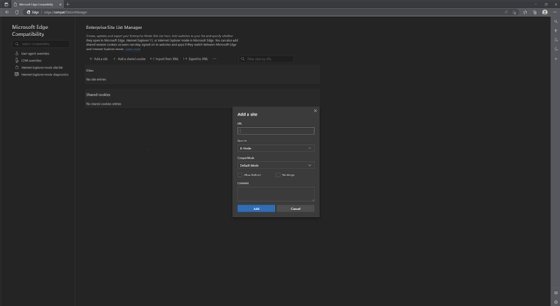
Getty Images
How to enable Internet Explorer mode on Microsoft Edge
Internet Explorer mode lets users view legacy IE websites not supported by other browsers, which can increase productivity and improve security for IT administrators.
Microsoft's updated Edge browser includes Internet Explorer mode -- or IE mode -- a feature that renders legacy IE websites as Internet Explorer 11 pages.
The latest generation of the Edge browser uses the Chromium platform, an open source browser project whose goal is to make the web faster, safer and more stable for users. With Internet Explorer mode included in Edge, end users can work with modern and legacy applications without switching between browsers or relying on the retired Internet Explorer browser.
Administrators can easily enable the feature across their managed desktops so specific websites will automatically render in IE mode when users access them. Alternatively, users can manually enable the feature to apply IE mode to other websites.
What is Internet Explorer mode, and why is it important?
Internet Explorer mode enables users to access modern and legacy websites within a single browser. The Chromium engine built into the browser uses the same technology that underlies Google Chrome, making it well-suited for modern web applications. However, the Chromium engine isn't meant for IE-based websites, which some organizations continue to support. For this reason, Edge also includes the Trident (MSHTML) engine from Internet Explorer 11, enabling users to work with web applications created for IE alongside modern web apps.
When users enter IE mode, in-page navigations such as links, forms and scripts all stay on the page, so users can navigate the website as though working in Internet Explorer 11. However, such actions as clicking the back button or entering a different URL in the address bar will cause the browser to slip back into Chromium mode unless the target page is also enabled for IE mode.
Edge Chromium compatibility mode supports most Internet Explorer functionality, such as Edge extensions, document modes, enterprise modes, security zone policies, Browser Helper Objects and Internet Explorer F12 developer tools. However, IE mode does not support features such as Internet Explorer toolbars, navigation menu policies or Edge F12 developer tools.
Organizations can use Internet Explorer mode to continue to view IE-based websites as they transition away from Internet Explorer, which will be permanently disabled on February 14, 2023.
How to enable Internet Explorer mode on Edge
There are several ways to enable IE mode on Edge, but the most common is to use the Enterprise Site List Manager after enabling Internet Explorer compatibility.
Internet Explorer compatibility settings
Before users or administrators can dictate which sites can be opened in Internet Explorer mode, they must first enable Internet Explorer compatibility through the following steps:
- Open Microsoft Edge.
- Click Settings and more, marked with an ellipsis, in the top right corner.
- Select Settings.
- Click Default browser from the list on the right.
- Under the Internet Explorer compatibility section, set the option to Allow for Allow sites to be reloaded in Internet Explorer mode (IE mode).
- Click the Restart button to refresh the browser and implement the changes.

They must then restart their browsers, making the feature available to individual websites. After enabling IE mode, users can manually apply it to individual websites by following these steps:
- Go to the website.
- Click the Settings and more ellipsis in the upper right corner.
- Point to More tools, and then click Reload in Internet Explorer mode.
Edge will reload, and the page will display an IE logo indicator, which the user can click to view more information. A banner will appear at the top of the page with a message about IE mode and Edge, along with an option for exiting IE mode.
Enterprise Site List Manager
Administrators that manage Windows 11 computers and the Edge browser can configure IE mode on their end users' computers using tools such as Group Policy Management Console, Microsoft Intune or Microsoft's Enterprise Site List Manager.
Enterprise Site List Manager is an in-browser tool that lets an administrator manage an organization's site list, found at edge://compat/SiteListManager. The enterprise mode site list should include all the website URLs that require Internet Explorer. When users connect to one of the listed sites, the browser will automatically render the page in IE mode without the user having to take any actions. Any URLs that users go to that are not on the list render as modern websites.
To add sites to Enterprise Site List Manager, follow these steps.
- In Enterprise Site List Manager, select Add a site.
- Type the website's URL in the dialog box and select Open in IE Mode from the dropdown menu.
- Click Add to save the URL and settings to the site list.

After adding the list of websites, admins should save it to an XML file and store it in an HTTPS location, network share or local computer. Microsoft recommends using HTTPS, although a local folder works fine for testing.
Administrators can use the EnterpriseModeSiteListManagerAllowed group policy to allow users access to the site list manager tool. When enabled, users can view the Enterprise Site List Manager on the left pane in edge://compat.
While implementing Internet Explorer mode is straightforward, IT's efforts will need to focus on maintaining the site list. However, the list will likely grow smaller over time as IE-based applications reach end of life and more applications use modern technologies. Until then, IE mode could prove a useful asset to organizations still supporting IE-based applications and looking for ways to simplify their operations and improve the user experience.








